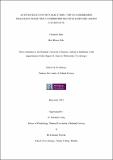| dc.description.abstract | The current research focuses on how adolescents stigmatise their peers with depression and explores this theme in a series of three interrelated studies. Study 1 tests an empirical model of public stigma towards depression based on its theoretical conceptualisation. It is proposed that stigma is composed of separate cognitive, affective and behavioural elements. However, empirical validation of this tripartite model among adolescents is lacking. Additionally, there is a paucity of research investigating the validity of instruments used to assess stigma among adolescent populations, with researchers typically relying on adult measures. In order to address these research gaps, exploratory (N=332) and confirmatory (N= 236) factor analyses were conducted on two separate samples of Irish adolescents. Results provided empirical support for the tripartite model of stigma, whilst also highlighting discrepancies between the validity of stigma instruments among adult and adolescent populations. Using the same sample as Study 1, Study 2 examines how select dispositional and situational factors may influence adolescents’ (M = 15.49 years, SD = 1.14) stigmatising responses. It is argued that investigating the factors that lead to the expression of stigma is an important step in designing effective stigma reduction strategies. Although other social psychological research indicates that empathy and peer norms may influence individuals’ stigmatising responses, the role that these two factors play in influencing stigma responses among adolescents is relatively under explored. Specifically, Study 2 explores the predictive effect of (affective and cognitive) empathy and (descriptive and injunctive) group norms on adolescents’ explicit and implicit stigmatising responses toward (hypothetical) male and female peers with depression. Results indicated that descriptive norms exert a substantial influence on adolescents’ explicit stigma responses. Based on the results from Study 2, Study 3 examines the utility of a pilot, normative feedback technique at reducing explicit stigma responses in adolescents. Specifically, Study 3 investigates whether exposing adolescents (N=116) to positive normative messages reduces the expression of stigma among these adolescents, at a follow-up assessment, in comparison to a control condition. Additionally, Study 3 assesses the mechanisms that are proposed to mediate and moderate the effectiveness of normative approaches. Results indicate that normative feedback was not effective at reducing stigma in this instance. Furthermore, no support was provided for the moderation effects, although some support was identified for the mediational effects of descriptive norms. This research makes important contributions to the literature. However, findings suggest that future research may benefit from further consideration of the methods that are used to assess stigma among adolescents. | en_IE |


